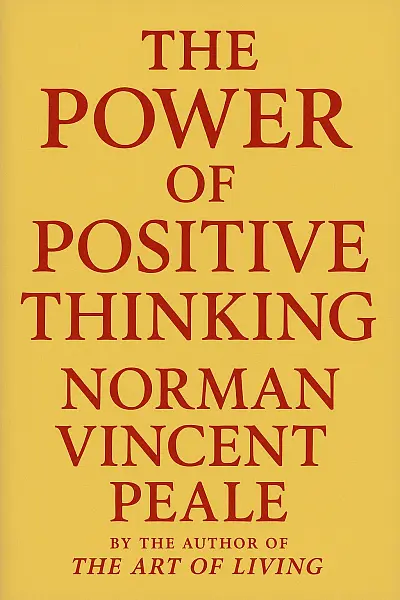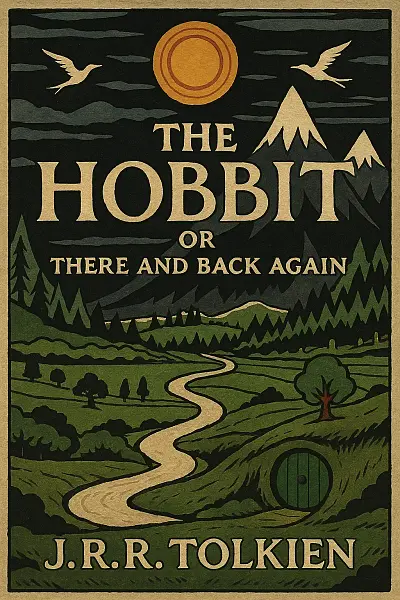
The Power of Positive Thinking
The Power of Positive Thinking puts readers right in the heart of their daily struggles, surrounded by self-doubt and stress. Stuck in routines that sap their happiness, they're hungry for change but unsure where to start—until Peale's uplifting strategies crash into their lives, shaking up the negativity that holds them back.
Armed with practical advice, readers now face the inner conflict between their old, limiting beliefs and the promise of a more optimistic mindset. At stake is nothing less than their sense of fulfillment and emotional well-being—can they, with Peale’s wisdom, finally trade worry for confidence?
The style feels like talking with a passionate coach—relatable, warm, and loaded with actionable hope.
"Belief in a brighter outcome kindles the strength within us to shape our days anew."
Literary Analysis
Writing Style
Atmosphere
Radiates warmth and reassurance throughout; every page feels like a pep talk from a kind mentor. The environment is relaxed, inviting, and underpinned by an optimistic spirit, with frequent references to faith, hope, and achievable happiness. There’s a persistent sense of encouragement, as if the book itself is rooting for you to succeed.
Prose Style
- Conversational and unpretentious, like sitting across from someone who genuinely wants to help
- Frequently anecdotal—real-life stories and personal examples lighten up heavier concepts
- Repetitive by design, driving key points home for lasting impact
- Sprinkled with religious references and phrases drawn from Christian faith, though laid out in simple, accessible language
- Prefers short, direct sentences and positive affirmations—don’t expect flowery language or literary flourishes, but rather a down-to-earth, get-to-the-point approach
Pacing
- Unhurried, steady, and methodical; takes its time reiterating central themes to reinforce the message
- Each chapter centers on a specific principle, which gives the book a structure you can dip into at your own pace
- Consistent rhythm—no sudden twists or surprising turns, just a reliable cadence of advice and “you can do this” encouragement
Mood & Feel
- Upbeat, hopeful, and persistent, appealing to readers seeking motivation or a morale boost
- Imbued with genuine kindness and a grandfatherly sense of wisdom
- Even when addressing struggles or negative thinking, always circles back to positivity and empowerment
Reader Experience
Expect to feel personally addressed, like Peale is speaking right to you. The book’s tone is cheerleading, the style is direct, and the content is crafted to boost your spirits. If you like actionable advice, stories of ordinary people overcoming adversity, and a steady stream of encouragement—this is your vibe. If you prefer sharp literary style or subtle nuance, you might find the prose a bit plain or repetitive, but it's undeniably sincere.
Key Takeaways
-
A pastor’s pep talk that doubles as a life toolkit—uplifting sermons meet streetwise strategies
-
Real-life stories of ordinary folks conquering fear—think: job losses, heartbreak, even crippling self-doubt—through sheer mindset shift
-
Peale’s “believe and achieve” mantra, repeated like a rallying cry, seeps into every chapter (you’ll probably find yourself reciting it, too!)
-
That iconic “go confidently in the direction of your dreams” exercise—corny? Maybe. Weirdly motivating? Absolutely
-
Unexpected moments of vulnerability, as Peale admits his own battles with despair—a refreshing break from the usual “guru knows all” tone
-
Punchy affirmations and visualization techniques peppered throughout, almost begging you to scribble in the margins
-
A warm, conversational style—feels more like coffee shop encouragement than stern self-help sermon

Harness optimism to transform your life—timeless strategies for lasting change.
Reader Insights
Who Should Read This
If you're the kind of reader who loves a good pick-me-up and thrives on books that spark real optimism, The Power of Positive Thinking is basically written for you. This one’s for folks who want a big dose of encouragement—maybe you're into self-help, motivational reads, or just appreciate little mindset boosts to get through life's rough patches.
You'll probably enjoy this book if:
- You like stories, personal anecdotes, and practical tips woven together—Peale's style is super conversational and easy to follow.
- You're looking for tools to manage stress, boost your confidence, or just see life's glass as half full.
- Books about faith, spirituality, or personal transformation totally light you up (there are Christian elements, but the positive outlook stuff is pretty universal).
- You don’t need a ton of science or research—this is more heartfelt wisdom than hard data.
- You're a fan of classics in the self-help world or want to see where the whole “power of positivity” trend started.
But consider skipping it if:
- You like your inspiration grounded in modern psychology or solid scientific backing—Peale leans into optimism and faith rather than evidence-based analysis.
- You’re not keen on repetitive advice or stories (the book circles the same points quite a bit).
- Heavy religious themes might not be your thing—there’s a lot of Christian philosophy here.
- You prefer dry facts or actionable “how-to” guides over cheerleading and big-picture thinking.
Honestly, this book is like a warm pep talk from a wise, always-hopeful uncle. If that appeals to you, you’ll find tons to love. If you’re looking for nuance, modern research, or secular takes on positivity, it might not totally hit the spot.
Story Overview
Looking for a mindset shift? The Power of Positive Thinking by Norman Vincent Peale is an uplifting guide that explores how your thoughts can shape your success, happiness, and resilience in everyday life.
Peale introduces relatable stories and practical strategies, inviting readers to confront the doubts and negativity that can hold them back.
💡 The overall vibe is super encouraging and hopeful, making you feel like you’ve got a wise, optimistic friend cheering you on every step of the way!
Main Characters
-
Norman Vincent Peale: The inspiring author and narrator who shares personal anecdotes and lessons. He acts as a guide, empowering readers with practical strategies to adopt positive thinking.
-
Various Everyday Individuals: Real-life people facing doubts, setbacks, or low self-esteem. Their stories are woven throughout the book, showcasing how applying positive thinking transforms their lives.
-
Skeptics and Critics: Represent those resistant to Peale’s ideas or struggling with negativity. Their doubts highlight the obstacles to adopting a positive mindset and set up Peale’s core arguments.
-
Supportive Mentors/Advisors: Occasional wise figures—counselors, friends, religious leaders—who offer guidance or encouragement. They reinforce the book’s message by modeling optimistic beliefs and behaviors.
If You Loved This Book
If you found inspiration in Stephen R. Covey's classic, The 7 Habits of Highly Effective People, then you’ll instantly connect with The Power of Positive Thinking. Both books offer a roadmap to transforming one’s mindset, but while Covey zeros in on strategic habits for success, Peale’s standout strength is his unwavering focus on optimism as fuel for personal growth. It’s like comparing a practical toolkit with a pep talk you actually believe—each leaves you feeling empowered, just in different ways.
Fans of Rhonda Byrne’s The Secret will recognize familiar territory here, especially in how both works champion the idea that our thoughts can directly shape our reality. Where Byrne sprinkles in the allure of manifesting and the law of attraction, Peale brings it down to earth, anchoring his advice in simple, repeatable affirmations and grounded daily practices.
On screen, think of Ted Lasso—that relentlessly upbeat series that isn’t afraid to get serious about the power of a positive attitude. Much like Peale's writing, the show manages to highlight the infectious impact of hopefulness, even in the face of adversity. Both remind us that belief—whether in ourselves or our teams—can spark real-world change and uplift those around us.
Expert Review
Is a happier, more fulfilling life really just a matter of attitude? The Power of Positive Thinking throws this question into bold relief, challenging readers to consider the staggering influence of mindset over circumstance. Norman Vincent Peale’s book exudes the conviction that optimism and faith are not merely feel-good mantras—they’re active tools for shaping destiny and conquering adversity. The sheer audacity of Peale’s promise—a happier, more “worthwhile” life—makes you wonder: does belief, alone, truly spark deep, lasting change?
Peale’s writing style is strikingly approachable. There’s a blend of conversational warmth and pastoral authority that keeps the pages brisk and inviting. Rather than heavy theory, he leans on crisp anecdotes and practical exercises, inviting readers to substitute negative self-talk with empowering affirmations. This simplicity is a double-edged sword: on one hand, it democratizes self-help, making the book accessible to anyone, regardless of background. On the other, the writing can feel repetitive and, at times, veers dangerously close to sermonizing—there’s little narrative variation, no dramatic arc, just iteration upon iteration of his core message. At its best, the prose is crystalline; at its worst, it risks sounding like a motivational workshop handout.
In terms of thematic depth, The Power of Positive Thinking is an unabashed celebration of perseverance, faith, and the active cultivation of hope. Peale roots his philosophy in Christian ethics but notably extends his reach beyond narrow religiosity, tapping into a universal longing for meaning and self-assurance. This makes the book culturally resonant, especially in a world grappling with anxiety and burnout. The text suggests that obstacles are as much internal as external—an insight with enduring appeal. However, Peale often skims past the complexities of mental health and systematic adversity. His prescription for optimism can feel overly simplistic, sometimes dismissing the real psychological and structural barriers that many face. Yet, his unwavering insistence on the malleability of attitude continues to strike a chord for those searching for self-mastery and peace.
Contextually, Peale’s work is a cornerstone of the self-help tradition—a spiritual forebear to The Secret and countless modern affirmational texts. His particular mix of spirituality and practicality set a blueprint for subsequent generations of motivational authors. Unlike some later works, however, The Power of Positive Thinking is less about “manifestation” and more about reframing daily thought patterns through practice, not just wishful thinking. In Peale’s own oeuvre, it’s arguably his defining legacy: the DNA for countless positive psychology movements.
Strengths: passionate readability, practical suggestions, accessibility
Weaknesses: repetition, oversimplification, limited engagement with adversity’s complexity
Bottom line? Peale’s message is both its magic and its limitation—instantly energizing, but sometimes too neat for the real world. Still, The Power of Positive Thinking remains a cultural touchstone for a reason. It’s worth reading for its sheer optimism and historic significance, even if its answers might not fit every reader’s questions.
Community Reviews
I ALMOST QUIT when Peale said to picture success on repeat, but somehow I kept reading. Maybe I just wanted to see if he’d say something wild next. Not sure if my brain’s rewired but I can’t stop thinking about optimism now.
So there’s this line: "Change your thoughts and you change your world." It latched onto my brain like a catchy jingle. Kept replaying in my head every time I doubted myself. Honestly, it’s still echoing.
I THOUGHT I COULD JUST SKIM THROUGH IT, BUT THAT ONE LINE—"Change your thoughts and you change your world"—kept echoing in my head, making me rethink every grumpy morning. Didn’t expect a book to linger like that.
Never thought a book could hijack my brain like this but Peale's relentless optimism actually made me question my own cynicism. That part about “change your thoughts and you change your world” stuck in my head for days.
I still can’t get over that one line: “Change your thoughts and you change your world.” It circled in my head for days, like a mantra I never planned to adopt but now can’t shake.
Cultural Context & Discussion
Local Perspective
The Power of Positive Thinking by Norman Vincent Peale really strikes a chord in the United States, thanks to its deep roots in American optimism and that classic “can-do” spirit.
- The message of self-reliance and overcoming adversity echoes the grit seen in eras like the Great Depression and the post-WWII boom, when folks leaned hard into hope and personal transformation.
- Peale’s blend of Christian values with practical advice feels totally in sync with traditional American religious culture, especially in communities where faith and self-betterment go hand in hand.
- At the same time, the book’s almost relentless positivity can feel a bit jarring for those wrestling with systemic issues—sometimes it brushes past the reality of inequality or collective struggle, favoring individual solutions.
- Stylistically, Peale’s conversational, almost sermon-like delivery draws on a lineage of American self-help and inspirational writing but might clash with those preferring a more nuanced or literary approach.
All in all, this book mirrors the U.S. cultural landscape: practical, faith-friendly, and rooted in the belief that change starts from within—but it also stirs debate about how much personal positivity can do in the face of real-world setbacks.
Points of Discussion
The Power of Positive Thinking by Norman Vincent Peale
Controversies:
- Many critics have charged the book with promoting superficial, unrealistic optimism and criticized Peale’s reliance on anecdotal evidence over scientific research.
- It’s also sparked debates in religious and psychological circles—some argue it oversimplifies complex emotional struggles, while others accuse Peale of blending faith with pseudo-psychological advice.







